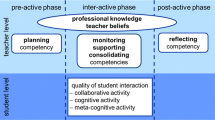Abstract
Teachers are the most important agents in shaping education for students and to bring change and innovation in educational practices. There is a lack of knowledge about how teachers learn and transfer their knowledge into practice in the classrooms. Teacher educators have repeatedly argued that classroom management is a critical pedagogical skill that teachers must master in order to maximize classroom interaction. This study aims to contribute to the understanding of how lower secondary school teachers learn and improve classroom interaction in the context of an educational intervention. Three aspects of classroom interaction are addressed: emotional support, classroom organization and instructional support. The sample contained 81 teachers from 14 Norwegian lower secondary schools reporting, through digital logs, on learning experiences with respect to classroom interaction. Moreover, they reported on the types of learning activities they undertook. Findings indicated that teachers’ improvement in classroom interaction was, to a large extent, dependent on their own, or their colleagues’ strong knowledge of classroom interaction. The results of the study add to our understanding of teachers’ knowledge and skills within classroom interaction and how teachers can improve their knowledge, e.g., through reflection on situations in the classroom. Still, the authors suggest a stronger emphasis on the integration of research based knowledge and teacher learning strategies to support teachers to reach their full teaching potential.
Similar content being viewed by others
References
Allen, J., Gregory, A., Mikami, A., Lun, J., Hamre, B., & Pianta, R. (2013). Observations of effective teacher-student interactions in secondary school classrooms: Predicting student achievement with the classroom assessment scoring system—Secondary. School Psychology Review, 42, 76–98.
Baker, P. H. (2005). Managing student behavior: How ready are teachers to meet the challenge? American Secondary Education, 33, 51–64.
Bakkenes, I., Vermunt, J. D., & Wubbels, T. (2010). Teacher learning in the context of educational innovation: Learning activities and learning outcomes of experienced teachers. Learning and Instruction, 20, 533–548.
Blase, K. A., Van Dyke, M., Fixsen, D. L., & Bailey, F. W. (2012). Implementation science: Key concepts, themes, and evidence for practitioners in educational psychology. In B. Kelly & D. F. Perkins (Eds.), Handbook of implementation science for psychology in education (pp. 13–34). Cambridge: University Press.
Brandsford, J. D., Brown, A. L., & Cocking, R. R. (1999). How people learn: Brain, mind, experience, and school. Washington, DC: National Academy Press.
Brekelmans, M., Wubbels, T., & van Tartwijk, J. (2005). Teacher–student relationships across the teaching career. International Journal of Educational Research, 43, 55–71.
Brophy, J., & Good, T. (1986). Teacher behavior and student achievement. In M. C. Wittrock (Ed.), Handbook of research on teaching (3rd ed., pp. 328–375). New York, NY: Macmillan.
Butler, D. L., Lauscher, H. N., Jarvis-Selinger, S., & Beckingham, B. (2004). Collaboration and self-regulation in teachers’ professional development. Teaching and Teacher Education, 20, 435–455.
Carver, S. M., & Klahr, D. (2001). Cognition and Instruction: 25 years of progress. Mahwah, NJ: Erlbaum.
Catts, H. W., Fey, M. E., Zhang, X., & Tomblin, J. B. (1999). Language basis of reading and reading disabilities: Evidence from a longitudinal investigation. Scientific Studies of Reading, 3, 331–361.
Davis, E. A., & Miyake, N. (2004). Explorations of scaffolding in complex classroom systems. Journal of the Learning Sciences, 13, 265–272.
Domitrovich, C. E., Bradshaw, C. P., Poduska, J. M., Hoagwood, K., Buckley, J. A., Olin, S., et al. (2008). Maximizing the implementation quality of evidence-based preventive interventions in schools: A conceptual framework. Advances in School Mental Health Promotion, 1, 6–28.
Emmer, E. T., & Sabornie, E. J. (2015). Handbook of classroom management (2nd ed.). New York, NY: Routledge.
Emmer, E. T., & Stough, L. M. (2001). Classroom management: A critical part of educational psychology, with implications for teacher education. Educational Psychologist, 36, 103–112.
Eraut, M. (2004). Informal learning in the workplace. Studies in Continuing Education, 26, 247–273.
Eraut, M. (2007). Learning from other people in the workplace. Oxford Review of Education, 33, 403–422.
Ertesvåg, S. K. (2011). Measuring authoritative teaching. Teaching and Teacher Education, 27, 51–61.
Evertson, C. M., & Weinstein, C. S. (2006). Classroom management as field of inquiry. In C. M. Evertson & C. S. Weinstein (Eds.), Handbook of classroom management: Research, practice, and contemporary issues (pp. 3–15). Mahwah, NJ: Erlbaum.
Fixsen, D. L., Naoom, S. F., Blase, K. A., Friedman, R. M., & Wallace, F. (2005). Implementation research: A synthesis of the litterature. Tampa, FL: University of South Florida.
Freiberg, H. J., Stein, T. A., & Huang, S. (1995). Effects of a classroom management intervention on a student achievement in inner-city elementary schools. Educational Research and Evaluation, 1, 36–66.
Fujiki, M., Brinton, B., & Clarke, D. (2002). Emotion regulation in children with specific language impairment. Language, Speech, and Hearing Services in Schools, 33, 102–111.
Gamlem, S. T. M., & Munthe, E. (2014). Mapping the quality of feedback to support student’s learning in lower secondary classrooms. Stavanger: Universitetet i Stavanger, Det humanistiske fakultet.
Gibbs, G. (2002). Qualitative data Analysis: Explorations with NVivo. Buckingham: Open University Press.
Greenberg, M. T., Weissberg, R. P., O’Brien, M. U., Zins, J. E., Fredericks, L., Resnik, H., et al. (2003). Enhancing school-based prevention and youth development through coordinated social, emotional, and academic learning. American Psychologist, 58, 466–474.
Hafen, C. A., Hamre, B. K., Allen, J. P., Bell, C. A., Gitomer, D. H., & Pianta, R. C. (2015). Teaching through interactions in secondary school classrooms: Revisiting the factor structure and practical application of the classroom assessment scoring system-secondary. Journal of Early Adolescence, 35, 651–680.
Hamre, B. K., & Pianta, R. C. (2005). Can instructional and emotional support in the first-grade classroom make a difference for children at risk of school failure? Child Development, 76, 949–967.
Hande, H. S., Kamath, S. R., & D’Souza, J. (2014). Students’ perception of effective teaching practices in a Medical School. Education in Medicine Journal, 6, 63–66.
Henley, M. (2010). Classroom management: A proactive approach (2nd ed.). Boston, MA: Pearson.
Hunt, G. H., Touzel, T. J., & Wiseman, D. G. (2009). Effective teaching: Preparation and implementation. Springfield, IL: Charles C. Thomas Publisher Ltd.
Justice, L. M., Meier, J., & Walpole, S. (2005). Learning new words from storybooks: An efficacy study with at-risk kindergartners. Language, Speech, and Hearing Services in Schools, 36, 17–32.
Kim, Y. H., Stormont, M., & Espinosa, L. (2009). Contributing factors to South Korean early childhood educators’ strategies for addressing children’s challenging behaviors. Journal of Early Intervention, 31, 227–249.
Kretlow, A. G., Cooke, N. L., & Wood, C. L. (2012). Using in-service and coaching to increase teachers’ accurate use of research-based strategies. Remedial and Special Education, 33, 348–361.
Kunter, M., Baumert, J., & Köller, O. (2007). Effective classroom management and the development of subject-related interest. Learning and Instruction, 17, 494–509.
Lewis, R. (2006). Classroom discipline in Australia. In C. M. Evertson & C. S. Weinstein (Eds.), Handbook of classroom management Research, practice and contemporary issues (pp. 1193–1214). Mahwah, NJ: Lawrence Erlbaum Associates.
Loizou, E. (2009). In-service early childhood teachers reflect on their teacher training program: Reconceptualizing the case of Cyprus. Journal of Early Childhood Teacher Education, 30, 195–209.
Lorin, W. A. (2004). Increasing teacher effectiveness. Fundmentals of educational planning (2nd ed.). Paris: United Nations.
Manning, M. L., & Bucher, K. T. (2003). Classroom management: Models, applications and cases. Upper Saddle River, NJ: Prentice Hall.
Marzano, R. J. (2003). What works in schools. ASCD: Translating research into practice.
McTavish, D. G., & Pirro, E. B. (1990). Contextual content analysis. Quality & Quantity, 24, 245–265.
Meehan, B. T., Hughes, J. N., & Cavell, T. A. (2003). Teacher-student relationships as compensatory resources for aggressive children. Child Development, 74, 1145–1157.
Meirink, J. A., Meijer, P. C., & Verloop, N. (2007). A closer look at teachers’ individual learning in collaborative settings. Teachers and Teaching, 13, 145–164.
Meirink, J. A., Meijer, P. C., Verloop, N., & Bergen, T. C. M. (2009). Understanding teacher learning in secondary education: The relations of teacher activities to changed beliefs about teaching and learning. Teaching and Teacher Education, 25, 89–100.
Midthassel, U. V. (2006). Creating a shared understanding of classroom management. Educational Management Administration & Leadership, 34, 365–383.
Midthassel, U. V., & Bru, E. (2001). Predictors and gains of teacher involvement in an improvement project on classroom management. Experiences from a Norwegian project in two compulsory schools. Educational Psychology, 21, 229–242.
Ministry of Education. (1996). Læreplanverket for den 10-årige grunnskulen [National curriculum for primary and lower secondary education]. Oslo.
Ministry of Education. (2006). Læreplanverket for Kunnskapsløftet. [National curriculum for knowledge promotion in primary and secondary education and training]. Oslo.
Ministry of Education. (2011). Meld. St 22 (2010–2011) Motivasjon Mestring Muligheter: Ungdomstrinnet [Motivation, mastery, possibilities: Lower secondary school]. Oslo.
Ministry of Education. (2016). St.meld. 28 (2015–2016) Fag-Fordyping-Froståelse. En fornyelse av Kunnskapsløftet [Subjects-depth–understanding: A renewal of the curriculum]. Oslo.
Nahal, S. P. (2010). Voices from the field: Perspectives of first year teachers on the disconnect between teacher preparation programs and the realities of the classroom. Research in Higher Education, 8, 1–19.
Norwegian Directorate of Education and Training. (2016). Ungdomstrinn i utvikling [Secondary school in development]. Oslo: The Norwegian Directorate for Education and Training. Retrieved from www.udir.no/kvalitet-og-kompetanse/nasjonale-satsinger/ungdomstrinn-i-utvikling/skolebasert-kompetanseutvikling-ungdomstrinnet/fullskala/#uh-sektoren-som-tilbydere.
Omoteso, B. A., & Semudara, A. (2011). The relationship between teachers’ effectiveness and management of classroom misbehaviours in secondary schools. Psychology, 02, 902–908.
Peters, J. M., & Armstrong, J. L. (1998). Collaborative learning: People laboring together to construct knowledge. New Directions for Adult Learning and Continuing Education, 79, 75–85.
Pianta, R. C. (1999). Enhancing relationships between children and teachers. Washington, DC: American Psychological Association.
Pianta, R. C. (2006). Classroom management and relationships between children and teachers: Implications for research and practice. In C. M. Evertson & C. S. Weinstein (Eds.), Handbook of classroom management: Research, practice, and contemporary issues (pp. 685–710). Mahwah, NJ: Erlbaum.
Pianta, R. C., & Hamre, B. K. (2009a). Classroom processes and positive youth development: Conceptualizing, measuring, and improving the capacity of interactions between teachers and students. New Directions for Youth Development, 2009, 33–46.
Pianta, R. C., & Hamre, B. K. (2009b). Conceptualization, measurement, and improvement of classroom processes: Standardized observation can leverage capacity. Educational Researcher, 38, 109–119.
Pianta, R. C., Hamre, B. K., & Allen, J. P. (2012a). Teacher–student relationships and engagement: Conceptualizing, measuring, and improving the capacity of classroom interactions. In S. Christenson, A. Reschly, & C. Wylie (Eds.), Handbook of Research on student engagement (pp. 365–386). Boston, MA: Springer.
Pianta, R. C., Hamre, B. K., & Mintz, S. (2012b). Classroom assessment scoring system (CLASS): Secondary manual. Charlottesville: Teachstone.
Pintrich, P. R. (2004). A conceptual framework for assessing motivation and self-regulated learning in college students. Educational Psychology Review, 16, 385–407.
Potter, W. J., & Levine-Donnerstein, D. (1999). Rethinking validity and reliability in content analysis. Journal of Applied Communication Research, 27, 258–284.
Putnam, R. T., & Borko, H. (2000). What do new views of knowledge and thinking have to say about research on teacher learning? Educational Researcher, 29, 4–15.
Roland, P. (2012). Implementering av skole- utviklingsprogrammet Respekt. [Implementation of school-development program Respect] Stavanger: Senter for atferdsforskning, Doktorgradsprosjekt.
Romberg, T. A., Carpenter, T. P., & Dremock, F. (2005). Understanding mathematics and science matters. Mahwah, NJ: Lawrence Erlbaum Associates.
Shinn, M., & Yoshikawa, H. (2008). Toward positive youth development: Transforming schools and community programs. New York, NY: Oxford University Press.
Skibbe, L., Behnke, M., & Justice, L. M. (2004). Parental scaffolding of children’s phonological awareness skills: Interactions between mothers and their preschoolers with language diffi culties. Communication Disorders Quarterly, 25, 189–203.
Sokal, L., Smith, D. G., & Mowat, H. (2003). Alternative certification teachers’ attitudes toward classroom management. The High School Journal, 86, 8–16.
Stough, L., Montague, M., Williams-Diehm, K., & Landmark, L. (2006). The effectiveness of different models of classromm management instruction. Paper presented at the annual meeting of the American Educational Research Association, San Francisco, April.
Stronge, J. H., Ward, T. J., & Grant, L. W. (2011). What makes good teachers good? A cross-case analysis of the connection between teacher effectiveness and student achievement. Journal of Teacher Education, 62, 339–355.
Stronge, J. H., Ward, T. J., Tucker, P. D., & Hindman, J. L. (2007). What is the relationship between teacher quality and student achievement? An exploratory study. Journal of Personnel Evaluation in Education, 20, 165–184.
Taylor, B. M., Pearson, P. D., Peterson, D. S., & Rodriguez, M. C. (2003). Reading growth in high-poverty classrooms: The influence of teacher practices that encourage cognitive engagement in literacy learning. The Elementary School Journal, 104, 3–28.
Teddlie, C., Creemers, B., Kyriakides, L., Muijs, D., & Yu, F. (2006). The international system for teacher observation and feedback: Evolution of an international study of teacher effectiveness constructs. Educational Research and Evaluation, 12, 561–582.
Tesch, R. (1990). Qualitative research: Analysis types and software tools. Bristol, PA: Falmer.
Tseng, V., & Seidman, E. (2007). A systems framework for understanding social settings. American Journal of Community Psychology, 39, 217–228.
United States Department of Education Office of Planning Evaluation and Policy Development. (2010, March). ESEA a blueprint for reform: The reauthorization of the Elementary and Secondary Education Act. Retrieved from http://www2.ed.gov/policy/elsec/leg/blueprint/blueprint.pdf.
van Tartwijk, J., den Brok, P., Veldman, I., & Wubbels, T. (2009). Teachers’ practical knowledge about classroom management in multicultural classrooms. Teaching and Teacher Education, 25, 453–460.
Vermetten, Y. J., Vermunt, J. D., & Lodewijks, H. G. (2002). Powerful learning environments? How university students differ in their response to instructional measures. Learning and Instruction, 12, 263–284.
Vermunt, J. D. (1996). Metacognitive, cognitive and affective aspects of learning styles and strategies: A phenomenographic analysis. Higher Education, 31, 25–50.
Vermunt, J. D. (1998). The regulation of constructive learning processes. British Journal of Educational Psychology, 68, 149–171.
Vermunt, J. D. (2011). Patterns in student learning and teacher learning. Similarities and differences. In S. Rayner & E. Cool (Eds.), Style difference in cognition. Learning and management (pp. 173–187). New York, NY: Routledge.
Vermunt, J. D. (2014). Teacher learning and professional development. In S. Krolak-Schwerdt, S. Glock, & M. Böhmer (Eds.), Teachers’ professional development (pp. 79–95). Rotterdam: SensePublishers.
Vermunt, J. D., & Endedijk, M. D. (2011). Patterns in teacher learning in different phases of the professional career. Learning and Individual Differences, 21, 294–302.
Vygotsky, L. S. (1991). Genesis of the higher mental functions. In P. Light, S. Sheldon, & M. Woodhead (Eds.), Learning to think (pp. 32–41). Florence, KY: Taylor & Frances/Routledge.
Weinstein, C. S., Tomlinson-Clarke, S., & Curran, M. (2004). Toward a conception of culturally responsive classroom management. Journal of Teacher Education, 55, 25–38.
Westergård, E., Ertesvåg, S. K., & Rafaelsen, F. (2018). Preliminary validity of the classroom assessment scoring system in Norwegian lower secondary schools. Scandinavian Journal of Educational Researach. Advance online publication. https://doi.org/10.1080/00313831.2017.1415964
Wubbels, T., Brekelmans, M., den Brok, P., Wijsman, L., Mainhard, T., & van Tartwijk, J. (2015). Teacher-student realtionships and classroom management. In E. T. Emmer & E. J. Sabornie (Eds.), Handbook of classroom management (2nd ed., pp. 363–386). New York, NY: Routledge.
Zins, J. E., Bloodworth, M. R., Weissberg, R. P., & Walberg, H. J. (2007). The scientific base linking social and emotional learning to school success. Journal of Educational and Psychological Consultation, 17, 191–210.
Author information
Authors and Affiliations
Corresponding author
Appendix 1. Questions for the digital log
Appendix 1. Questions for the digital log
-
1.
Describe an academic situation where you learned something. What did you learn?
-
2.
How was this learning related to classroom management?
-
3.
What thoughts/considerations did you have about this learning experience? For example, was it planned? How? What reflections or thoughts did you have before and after this learning experience? What did you feel (e.g., happy, frustrated, aggressive)?
-
4.
Why did you learn from this situation? For example, did you plan a lesson, or did it happen spontaneously? Was there anything during or after the lesson that contributed to your learning? What learning activities did you undertake alone or with colleagues?
-
5.
Did you learn anything from the situation that made you look at the classroom practice differently? What motivated you to learn more about classroom management?
-
6.
How can students benefit from what you have learned?
Rights and permissions
About this article
Cite this article
Solheim, K., Ertesvåg, S.K. & Dalhaug Berg, G. How teachers can improve their classroom interaction with students: New findings from teachers themselves. J Educ Change 19, 511–538 (2018). https://doi.org/10.1007/s10833-018-9333-4
Published:
Issue Date:
DOI: https://doi.org/10.1007/s10833-018-9333-4








